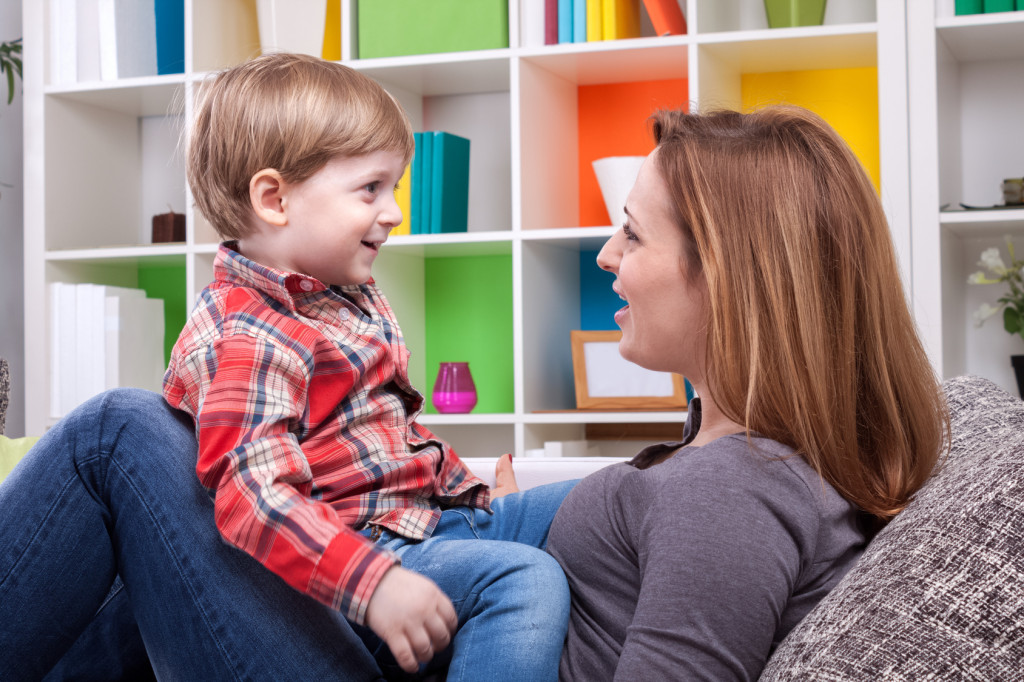How Should I Talk to My Child if They Have a Language Delay? – Ask Sarah Series

Last month, I shared my rule of thumb as I continued to try to answer Mary’s question about her son who had recently been diagnosed with autism. I talk to a child using sentence lengths which are one word longer than the lengths of the sentences they are currently using.
Mary, you mentioned that your son only has a few words, which would mean that his sentences are usually either 0 or 1 word in length. (When I say 0 words, I mean that he’s pointing or pulling your hand or babbling to get his point across, but not using any fully-formed words). In that case, I would speak in him in 1-2 word utterances. For example, if I know he wanted a ball, I would model “ball” for him while holding out the ball. By incorporating the visual cue, I’m helping build his understanding of language – while saying “ball” I am at the same time showing him the ball! After I give him the ball, I can take it from him and if he wants it again, I may model “more ball” so he starts to learn what the word “more” means. If I say to him, “Hi Zachary, do you want to play with the ball, it will be so fun, I know you like the ball,” he will just look at me with a blank look, because he probably doesn’t know what ANY of those words mean, and in any event can’t process that many words strung together. At best, he might be able to pick out “ball” since it was repeated a couple of times, but it’s a lot harder for him to do that than if I’m just saying “ball” and “more ball.”
Below are some guidelines on the approach you should take when speaking to your child, based on the number of words your child usually uses in a sentence (if you’re not sure, your therapist will be able to quickly tell you):
If your child usually uses this many words together when they say something, then you should take this approach when you speak with them:
0 words:
Talk to your child using mostly single words. At times you can use some two-word combinations. Really exaggerate what you say, and use a lot of affect. Use visuals as much as you can, and also use gestures to help communicate your message. Auditory information is often difficult for children on the spectrum to process, so the visual information may really help their understanding (for example, if your child wants a ball, say, “ball” with a lot of exaggeration and affect while also holding a ball where they can see it).
1 word:
Talk to your child using mostly two-word combinations. At times you can use some three-word combinations. If your child is talking in single words that probably means they are starting to label a variety of words mostly nouns and they need to expand. Start just adding one word to their utterance. For example, if your child says “bike,” then you can model, “ride bike,” and then even try to have them imitate “ride bike.”
Using visuals to help their receptive language is important (e.g., have a picture of a bike to show your child while talking about bike). You can also use pictures to increase their length of utterance. For example, if you want to work on having your child add a color, you can hold up a picture of the color at the same time as you hold up a picture of the object, and then ask your child to point to each picture while labeling.
You can also combine gestures to help increase the length of utterance. For example, if your child says “juice,” because they want more juice, you can model “more juice” for them while at the same time using the sign for “more” to help with their comprehension.
2 words:
Talk to your child using three to four word combinations. Try to avoid having your child “script” memorized phrases. Very often I see families whose child is starting to use words, and the family wants the child to use really LONG sentences. This is very difficult for a child who is just starting to put together a few words at a time.
To put it in perspective, imagine you are learning a foreign language. You won’t be able to put together a full sentence in your new language until you first know what each word in the sentence means. Sure, you could memorize a few stock phrases such as “where is the bathroom?” but you can’t start putting together a novel sentence on your own until you know what each word in the sentence means. So with your child you want to work on first building up their comprehension of a variety of nouns, verbs, descriptors, adjectives, and pronouns, which are the fundamental “building blocks” of sentences. Then you also need to work on building up your child’s understanding of grammar, which are the “rules of the road” for putting those building blocks together. Only then when they have all the fundamentals in place will they be able to build up to long sentences.
Again think back to when you were just starting to learn a foreign language – while learning, if someone spoke a longer (five- to six-word sentence) to you, you probably would be able to parrot it back and repeat it to them, but without a solid basic understanding of the vocabulary and grammar, you would have no idea what it meant unless you had learned it by rote.
Another note for this level: don’t worry about whether your child is using words such as “please” and “thank you.” Yes, it is polite, but it is much more important to work on your child using more functional words so that they can communicate basic wants and needs. Then you can add in those “pleases” and “thank yous”.
Finally, one of the best things you can do for your child when they are working at this level is to constantly talk about and narrate to your child everything you and they are doing throughout your days, using simple three- to four-word sentences (e.g, “you have ball”; “train says choo choo”). It sounds simple, but it provides much needed repetition and practice.
3 or more words:
Make sure your child is using variety in their sentences. This demonstrates real mastery of the language, as opposed to just rote memorization of stock phrases or scripting what your child may have heard from you or from media sources. You may think your child is speaking in long sentences just because they say “I want big cracker please,” but they may just be using the same few learned combinations. So try to be observant of what your child saying, and note if they are repeating the same phrases or combinations of words.
If you do see a lot of repetition, then help them by modeling a variety of alternatives to the crutch of learned phrases. And remember not to get caught up on the length of their sentences – your goal should be quality, not quantity.
For more information on this series, please see our introductory post: Ask Sarah



